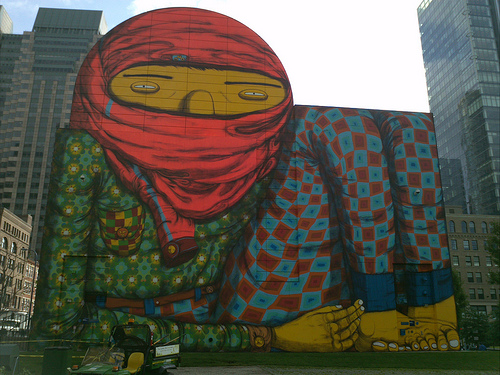Interviewer: How would you describe your own style?
Os Gemêos: A tiny boat in a huge ocean with all its infinity and surprises.
– Artists Os Gemêos in Art Crimes
Over the past half-century — since the days of the actual “Madmen” — advertisers have transformed public space. The former understood that in an age of cutthroat economic competition, every surface of the city needed to become a canvas for publicizing the joys of consumerism. Along with the advertisers, mainstream policy-makers have pushed for the transformation of civic geography across the world into giant shopping malls that would attract public consumption and thus greater corporate investment.
In contrast, progressives oriented around “the right to the city” have argued that commodification has led social and economic policy away from a focus on citizen entitlements. The advocates of the right to the city believe that municipalities hold ecological, economic and redistributive social functions that are meant to serve all of their populations; that is, the wealth-producing capacity must be subservient to a social justice function. Examples of the aspiration for greater redistribution have been struggles for services, housing, health care, food, improved public space and urban land tenure.
Along with social movement campaigns to redefine the city, artists have also reconsidered the use of public space. While advertisers promoted a billboard topography, street artists have encouraged the notion that expressive activity should not be limited to canvases in a studio; the doors, walls, bridges and fences of a society should also become surfaces on which artists sketched their visions.
Perhaps the most interesting graffiti artists of our time are the identical Brazilian twins Gustavo and Otavio Pandolfo, born in 1974, and known as Os Gêmeos. The twins have remarked that Brazil’s traditional inequalities impelled its citizens to continuously improvise and that this spirit of invention has been their own greatest inspiration: Os Gêmeos’ work blends metropolitan themes with rural traditions, geometric patterns with flowering colors, and unexpected images of fish feeding on stars juxtaposed against men fishing for illusions.
The politics of their work has recently risen to prominence: the twins were commissioned to paint a giant mural in Dewey Square in Boston. The wall painting depicted what Os Gêmeos — perhaps coyly — stated was a little boy with a pajama top wrapped around his head. The illustration was quickly criticized by conservatives for being a depiction of a veiled Muslim, that is, an image that they believe does not deserve to exist in public visual space in the post-911 era.
Beyond the sexism of the response it is also noteworthy that these defenders of the sanctity of public visual space rarely criticize billboards that advertise automobiles, Android phones or anorexic models. Perhaps reception of the image would have been different if the pair had their hooded youngster sipping a Diet Coke. Consumer advertising has become so normalized that it now rests in a domain that lies almost beyond ethical judgment. The good news is that the mural has provoked a much-needed discussion of the uses of public space.
Street artists, like the Brazilian twins, are expanding not only our notion of the arena that art should inhabit but also our conception of the right to the city: municipal space should not only be oriented in terms of consumerism or economic redistribution but also by provocative aesthetic inspiration.
Thomas Ponniah was a Lecturer on Social Studies and Assistant Director of Studies at Harvard University from 2003-2011. He remains an affiliate of Harvard’s David Rockefeller Center for Latin American Studies and an Associate of the Department of African and African-American Studies.
Photo: charlene mcbride/Flickr




